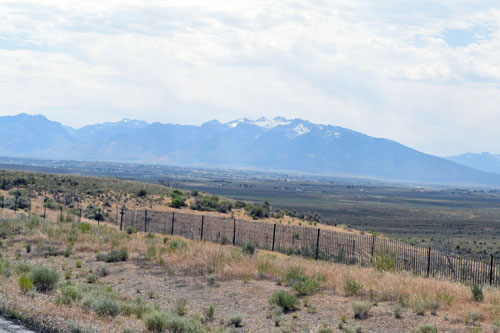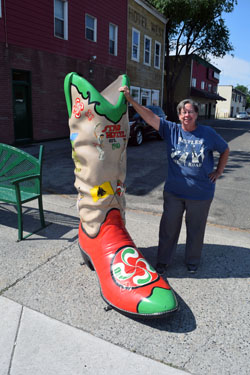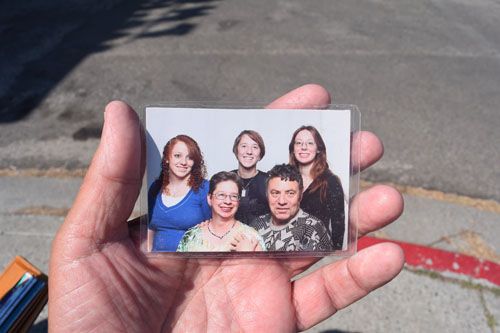
Editor’s Note: Editor Donald H. Harrison and his grandson Shor recently completed a 2,000-mile journey through California and Nevada, collecting and photographing Jewish stories along the way. This article is the sixth and final article in a series generated during that trip.
By Donald H. Harrison


ELKO, Nevada – It’s approximately 600 miles roundtrip between Reno and this gold mining town in eastern Nevada. Given that some 30 years ago the former Pamela Bloss made that trip at least once a week for several months to meet with a rabbi is a strong indication of how important her conversion to Judaism was for her. After meeting wtih Conservative Rabbi Joseph Teischman for a while, he introduced her to Israeli emigrant Baruch Zohar, whom she later married. Little did she know then that she would end up as one of the leaders of Elko’s tiny Jewish community.
Pamela Zohar’s story began in Nashville, Tennessee, where she grew up in the fundamentalistm non-instrumental Church of Christ, which she described as a “small denomination that tells you they are not a denomination; they are the true church and everybody else is wrong. It wasn’t bad to grow up in it as a small kid. It was a very tight community, with a lot of security but when you get a little bit older, it is very stifling.” Among the church’s teachings, she said, were that “fossils were put into the ground by Satan to deceive us or alternatively by God to test our faith.” She said her mother taught her that “Protestants were Protestants, Catholics were Catholics and none of them were true Christians.”
Furthermore, church leaders “told us that they were the first century church; they put ‘Established 33 A.D.’ on the cornerstone. They said there was always a remnant worshiping like they did ever since the First Century.” Contemporary religious historians say the non-instrumental (meaning musical instruments are not used in the service; singing is acapella) Church of Christ was established in the 1800s during the same American Restoration Movement that also saw the rise of the Church of Latter Day Saints. Some members of the church know that, but chose to ignore it, according to Zohar.
As a child, she experienced a disconnect between what she learned in church and what she learned in school. When one day she learned in school that there is a real city in Syria called Damascus, it was a revelation. Damascus wasn’t only one of her church’s Bible truths; this was a real-world truth.
Vanderbilt University brought additional realizations. She started off as a business administration major, but needed to take a science. She chose geology – remembering as a child that she always enjoyed finding pretty rocks – and was surprised by how easy and fun the courses were for her. She’d finish tests in 15 minutes and wonder why everyone else was still bent in concentration over their desks. Of course, among geologists, no one believes that the fossils were put into the ground by Satan. She graduated with a joint major.
Pamela continued her geology studies at the University of Georgia (Athens), and made connections that led to jobs with some small mining companies in Nevada and eventually to an opportunity to work as a geologist for Barrick Gold Corporation, a Canadian company that grew into the largest producer of gold in the world. In 1987, the year she joined Barrick, the company purchased the Goldstrike Mine in Elko, one of several mines in owns in Nevada and around the world. “I worked in exploration and in the first ten years Barrick had it, we increased the reserves from over 1 million ounces of gold to over 43 million. It is now one of the premier gold mines in the world, producing over one million ounces per year.”
When not working, Pamela was embarked on a spiritual search for some belief system to replace that of her parents’ church. “I got to be about 30 or 31 and I had been working, had a house and a dog, and I realized I wasn’t happy being nothing. I said I know my church doesn’t have it right, but what about the others? Being raised the way I was, I put a great deal of importance on being right, because they put a huge amount of importance on being right, or you’re damned forever. That even includes things like whether you can put pads on pews – everything is a salvation issue. They spent four years when I was a kid arguing whether it was biblical to put pads on the pews. If it wasn’t in the New Testament, was it okay to do it?”
Pamela embarked on an independent course of study. “I read about different religions. Sikhism is quite attractive, but basically I came to realize it was not my tradition. Hare Krishnas lost me when they said it is an item of faith that the sun is closer to the earth than the moon is. Because of the way I was raised, I thought surely I had to be right about everything and there must be someone who is right about everything, so all I had to do was study and I would figure out who was right. Or else maybe the angel Gabriel would come down and tell me to be a Presbyterian, but it doesn’t work like that.”
What precipitated her interest in Judaism was that she enjoyed reading mystery novels, including the Harry Kemelman authored series with such titles as Wednesday The Rabbi Got Wet, featuring the fictitious crime solver, Rabbi Small. Kemelman “wrote a little book called Conversations With Rabbi Small and the premise was that a young couple wanted to be married, and one was Jewish and the other wasn’t and they came to talk to the rabbi about the fact that their parents were mad about it,” Pamela recalled during an interview.
“The first thing Rabbi Small told them was that he didn’t do intermarriages, but they started talking afterwards about Judaism. I read through the book, mostly because it was that author and I liked the Rabbi Small stories. Then I closed the book and put it away for a while, didn’t look at it, because I was scared – sort of like, ‘Oh my God, I believe all that!’ These were opinions I had come to by myself about the nature of God, the relationship with humans, and how you can know things. For me Judaism was more about the intellectual theology and much less about life style and practices. I was not in it for the matzo ball soup, and I still think gefilte fish is disgusting. And, I hate chopped liver.”
She kept reading more, checking out any book that even mentioned Judaism out from the local public library and from Northern Nevada Community College, now known as Great Basin College. “I read Leo Baeck, Abraham Joshua Heschel and even a little Soloveitchik, which was extremely difficult. But I was also struggling with everything that I had been taught and my automatic assumptions about God, people, life everything, It was very emotionally traumatic. I spent a year wrestling with this whole deal. I was at a point that I wasn’t sure that God exists even – which the way I was raised was a big deal, a huge sin.” And then one evening she bolted awake in bed, looked out the window, saw the moon over the mountains, and felt “absolutely positive that Sinai existed. I wasn’t sure about God, but I was sure about Sinai.”
She decided not long afterwards to begin formal study with Rabbi Teischman, although it meant that 600-mile roundtrip every week. If you Google Teischman’s name, you will find an article written by the Jews for Jesus movement contending that Rabbi Teischman was struggling with his faith, wanting to convert to Christianity but didn’t do so because he was afraid that he would be rejected by his people. He died of a massive heart attack the year after Pamela’s conversion, and if that was going on in his life – even as he was helping her as a Christian to convert to Judaism – it was unknown and unsuspected by her.
Perhaps, she suggested, Rabbi Teischman was pulling the wool over the eyes of some Christian clergyman who was proselytizing him. “But that he was seriously considering converting? No way!”
Reflecting on the conversion class that the rabbi taught, Pamela said: “I think one thing I appreciated a lot (given my background) was that he rarely told me what to think; instead he gave me tools and information so I could figure out what I thought for myself.”
Besides converting her, the rabbi also introduced her at an oneg Shabbat to Baruch Zohar, who had worked in construction in Israel and had found similar work in central Nevada. Baruch asked Pamela for a date, which she declined because “I didn’t date guys I only just met.” They saw each other again about six weeks later “and the rabbi introduced us again, I guess he forgot.” When Baruch renewed his invitation to go out to coffee, she agreed. She asked him to explain the difference between Israel’s Labor party and the Likud, and while he tried, “I thought he had really lovely hands.”
Knowing that Baruch was working at different jobs, but had not landed a steady one, Pamela suggested that he consider Elko where there was a mini boom in mining going on. One day, he surprised her by knocking at her door in Elko. “No one had ever chased me around before, and I didn’t know what to think. But he came here, found work at the mine, and we started dating, and after six months or so, he said to me, ‘I was talking with the rabbi and he said if we want to get married, he would do it for free.’ I said ‘Oh that’s nice.’ We kept dating; I still wasn’t telling my parents yet. I was studying for conversion and I am dating this Israel guy, and they know nothing. I was dreading the conversation.”
On Pearl Harbor Day (December 7th), “he was eating chili and he says to me in the middle of dinner, ‘Why don’t we take the rabbi up on his offer?’ This was my romantic proposal, and we got married on Flag Day, the next summer (1987). I completed my conversion, my husband didn’t really care. His mother is not religious, she lights candles on Friday nights ‘just because.’” While Baruch said he didn’t care about religion, “it’s just old stories,” in Pamela’s opinion, ‘he is so thoroughly Jewish, it is like water to a fish. He thinks he is so ‘modern,’ doesn’t believe in God, and he is so incredibly Jewish.”
After the proposal, they went to Reno and told Rabbi Teischman the news. “Oh,” he responded, “you’re going to get married? Mazal tov! How did you two meet?”
Pamela shook her head, “He only introduced us three times.”
The wedding turned out to be a very tense affair. Her mother took Pamela aside and told her, “You may have a very good life but you will burn in hell forever.”
After she and Baruch were married, Pamela “became an original member but not an organizer” of Elko’s fledgling Jewish community. “We got to know some other Jewish couples in Elko and we would try to do something Jewish. I think the very first Jewish holiday that the Jews of Elko got together to do something Jewish was Sukkoth in 1991. We went over to a friend’s house in Spring Creek, and built ourselves the most inadequate, poorest looking sukkah ever and we ate, not in the sukkah – we just looked at it and said we don’t want to be under that.”

The driving force for creating the Jewish Community of Elko County (JCEC) was Howard Copelan, who owned a newspaper in Wendover, Nevada. He and his wife were the only Jews in Wendover, and they were Orthodox, with their boys wearing kippot and tzitzit to school. “In February 1992 we filed our articles of incorporation with the state – a social, religious, educational not-for-profit organization. At least half the group from the beginning was intermarried; we had the one Orthodox couple, Zohar and I were Conservative. We had a couple from New York who were Reform-ish, and a bunch of very secular people who liked being Jewish once in a while, but God forbid they should pray!”
JCEC’s biggest annual event is a Passover seder. One year, “The Copelans were very upset by having barley turn up at the Passover seder. Someone said we know we’re not supposed to have wheat, so we have barley. So now the Copelans go to Salt Lake City (about equidistant as Elko from Wendover) and are members of Chabad there.
The advantage of incorporating was that it made the tiny congregation eligible for various benefits. The local ministers group changed its name to the Elko Religious Leaders Association to make it comfortable for Jews to participate, although the lay leadership of the congregation rarely attends. Occasionally, the congregation has been benefited by student rabbis, among them Elizabeth Beyer, who later became the spiritual leader of Reno’s Reform congregation, Temple Beth Or. Meeting space was easily obtained in the Presbyterian Church’s social hall.
There were at least three families, including Pamela’s with children the same age. The Zohar girls – Shoshana, Amanda, and Rebecca – went to parent-taught Hebrew school in Elko; celebrated their bat mitzvahs at Temple Emanu-El in Reno; and attended Camp Ramah in California. Today the girls are grown: Shoshana lives in Netanya, Israel, in close touch with Baruch’s family; Amanda is in graduate school at the University of Syracuse, and Rebecca tends bar in Elko. Presently there are no pre-bar/ bat mitzvah students in Elko; the youngest member of the congregation is 15, the next youngest is 18.
Pamela expresses the opinion that the Elko Jewish community could soon disappear because of lack of participation. She and her husband are planning to retire to Georgia, and another activist couple whose children also attended the Hebrew school plan to retire elsewhere. “If there is going to be a Passover seder, we have to do it,” she explained. “If there is going to be a sukkah, we have to build it. If there is going to be a bar mitzvah, we have to participate. This is not a place where you can be Jewish and sit back and just show up for things….
“Most of the members of the JCEC are school teachers or college professors. One is a lawyer, one is a social worker. There are a couple of doctors. It isn’t that there aren’t Jews in Elko. It is that the Jews who are in Elko aren’t strongly devoted to the idea of maintaining a Jewish community. We’ve had some people move here who would like more, and mostly they don’t end up sticking around for long.
“The impetus for us getting together originally is the same reason for us to fall apart now,” Pamela continued. “It was because we had young children and we wanted them to get a Jewish education, a Jewish identity.” Today, because of the Internet and Skype, the Jews of Elko do not feel so isolated nor so dependent on each other to have Jewish experiences. “When my kids were studying for their bat mitzvahs I was driving to Reno every week. The last kid in the community to have a bat mitzvah, Sasha, her classes were Skyped with Rabbi Beyer in Reno.”
As is the case in many small communities, once the children of Elko go off to college, they rarely come back to live. Little by little, sighs Pamela, Elko’s Jewish community is disappearing.
*
Harrison is editor of San Diego Jewish World. He may be contacted via donald.harrison@sdjewishworld.com